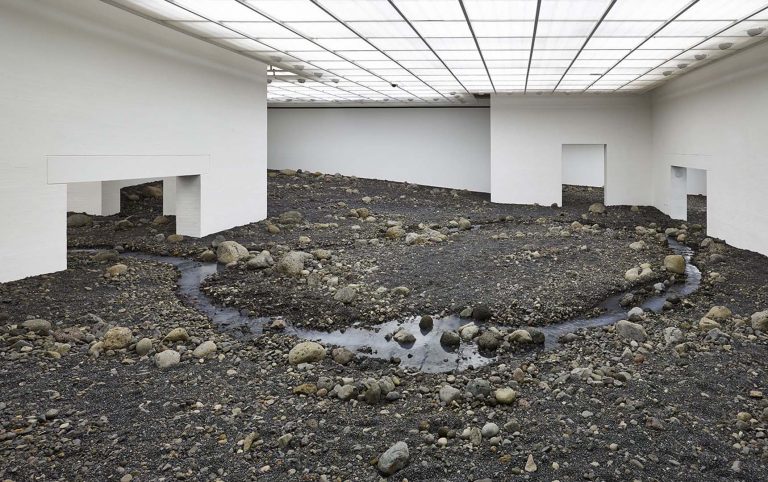We acknowledge the Traditional Owners of the land on which the Queensland Art Gallery | Gallery of Modern Art stands and recognise the creative contribution First Australians make to the art and culture of this country.

Olafur Eliasson / Denmark/Iceland b. 1967 / Riverbed 2014 / Water, rock (volcanic stones [blue basalt, basalt, lava], other stones, gravel, sand), wood, steel, plastic sheeting, hose, pumps / Dimensions variable / © Olafur Eliasson / Photograph: Anders Sune Berg / Courtesy: The artist; neugerriemschneider, Berlin; Tanya Bonakdar Gallery, New York/Los Angeles
Olafur EliassonRiverbed 2014
Not Currently on Display
Olafur Eliasson’s practice is informed by Iceland’s dramatic landscape, which features in several of his works addressing environmental issues, perception, and the relationship between the built and natural worlds.
Riverbed 2014 presents a rocky terrain, inspired by the artist’s walks through the Icelandic landscape. Although based on his own experience, the riverbed could be any number of places:
There is a feeling that there might once have been more water in the room, that the rest of the landscape was underwater at some point, or else it might soon be underwater again. It resembles a riverbed that has dried up and there is not much left other than the rocks.1
Eliasson originally conceived the work as a site-specific installation for the Louisiana Museum of Modern Art, Humlebæk, Denmark. The Louisiana’s modernist architecture offered a dynamic arrangement of smaller gallery spaces that visitors could navigate in order to reach the river’s source. Eliasson was interested in the choices the audience members made as they traversed the space: some followed others and some traced the footsteps of previous visitors, while others made they own way.
Endnotes:
1 Olafur Eliasson, ‘Riverbed reflections’ in Riverbed: Olafur Eliasson at Louisiana [exhibition catalogue], ed. Michael Juul Holm and Anna Engberg-Pedersen, Rosendahls, Denmark, 2016, n.p.
Olafur Eliasson is a Danish–Icelandic artist known for large-scale installations that employ natural elements, such as light, water and air, to enhance the audience’s experience. Driving Eliasson’s practice are his interests in space, perception and movement. Inspired to connect nature and art, many of his works recreate natural phenomena, and engage with a range of social and environmental issues. Eliasson’s works often challenge viewers’ perceptions of reality — he considers how an experience in a gallery setting might lead to a change in behaviour outside it.
For Eliasson, art is ‘very much about the way we link thinking and doing’:
So what is between thinking and doing? I would say, there is experience . . . Experience is about responsibility. Having an experience is taking part in the world. Taking part in the world is really about sharing responsibility.1
Endnotes:
1 Olafur Eliasson, Playing with space and light, TED Talk 2009 <https://www.ted.com/talks/olafur_eliasson_playing_with_space_and_light>, accessed November 2019.
Discussion
1. Eliasson believes actions are what create the difference between a picture and space. Discuss in relation to Riverbed.
2. During your visit, observe the behaviour of other visitors exploring the work and record this in drawings or photographs. Do they interact with the water or rocks? Do they move individually or as a group? Do they make their own way or follow the same paths as previous visitors?
3. Eliasson draws attention to the fact that we live in the Anthropocene era, a geological era characterised by the effects of human activity on the earth. What human acts do you think created what you see in Riverbed? How might our future actions change this landscape?
Activities
1. Draw or paint a landscape that shows Riverbed in the past. Create a second landscape of Riverbed in the future. Consider how much time has passed between past and future Riverbed landscapes.
2. Develop a 60-second piece of sound art expressing a personal memory of water, which you could share as a live performance or recording.
3. Investigate Eliasson’s glacial watercolours. Freeze small cubes of water collected from local sources such as river, creek, ocean, dam, bore or tank/rainwater. Add ink to paper, then place ice onto paper and allow it to melt. Reflect on resulting image and its connection to the landscape.